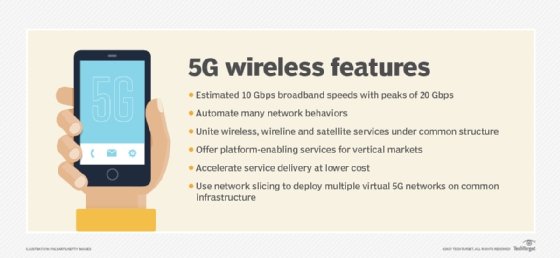distributed antenna system (DAS)
What is a distributed antenna system (DAS)?
In a distributed antenna system (DAS), a single signal source is connected to a group of antennas instead of to a single antenna. A DAS is most often used to distribute cellular network coverage to heavily populated buildings, such as offices, high-rise apartments, shopping centers or sports stadiums.
What does a distributed antenna system do?
A distributed antenna system is used to get wireless signal coverage to otherwise unserviceable areas. It places several smaller, less-powerful antennas in different locations instead of one large, powerful antenna. Cables connect the smaller antennas back to a single signal source.
An analogy can illustrate the usefulness of DAS. Imagine trying to play music for a large audience. If everyone is outside, a single powerful speaker would be the most effective, cheapest way to play music. Now imagine the crowd distributed throughout an office building. A single speaker in the middle of the building would be too loud in some places, too quiet in others, and echoes would distort the sound. Better is to put small speakers evenly throughout the building, with all playing the same music at a reasonable volume.
Cellular network service works similarly. The cellular providers place cell towers at high-elevation locations strategically throughout an outdoor area to provide even coverage. Like large speakers, these cell towers are powerful and work well outside. Inside a building, however, it's difficult for the receiver to detect the signal from outside. Any thick outside wall can block, or attenuate, the signal, an interior wall can cause the signal to bounce, and large amounts of people can all be competing for the same signal. To overcome these challenges, a DAS brings smaller antennas inside the building to more evenly distribute the signal.
DAS usually refers to cellphone signal coverage, not internet-connected Wi-Fi. A large-scale Wi-Fi system will more often be called a Wi-Fi deployment or mesh network. Often, Wi-Fi may be deployed simultaneously or even in the same equipment as a DAS, causing some confusion. For example, the New York Metropolitan Transportation Authority uses both DAS and Wi-Fi access points to provide both types of coverage to underground subway stations.
When designing a DAS, primary considerations are signal source and signal distribution type.
Distributed antenna system signal sources
The DAS must get its wireless signal to distribute from somewhere. This can be reused from another source outside the system, called off-air, or generated by the system itself, which may be small-cell systems or a larger base transceiver station (BTS).
Off-air distributed antenna system
An off-air DAS uses an antenna in one place, connected to many antennas somewhere else, to rebroadcast a signal. For example, a large antenna on the roof of a building picks up the signal from a nearby cell tower base station and retransmits it to small antennas connected throughout the building. This can be called a repeater because it does not generate any new wireless service but simply repeats whatever is already there. In the U.S., the Federal Communications Commission regulates these signal boosters.
An off-air DAS works best in locations with good cellphone coverage but might be hindered by the building's construction. Office and apartment buildings in metropolitan areas are good candidates for off-air DAS.
Deploying off-air DAS is fast, simple and cheap. They require minimal cooperation with cellphone service providers and can work with any carrier. Since they only retransmit signals, they reuse the existing cellular infrastructure.
Off-air DAS may not be suitable for rural locations or extremely high-density buildings. The existing signal strength or capacity may not be sufficient for the system.
Small-cell distributed antenna system
Small-cell DAS -- sometimes called microcell, picocell or femtocell -- occurs when a cellular service company provides equipment that generates a signal and uses a normal internet connection to link to the carrier's network. Since these systems generate their own signal, they are good for locations without coverage or with poor cell coverage. This includes rural areas or service dead zones.
Small-cell DAS are more complex and costly to set up than off-air ones. Successful use requires agreements with the cellular service providers and a high-bandwidth internet connection.
BTS distributed antenna system
BTS DAS is essentially an entire cell tower base station with many antennas in an area. They may also be called NodeB, or 3G; ENodeB, or 4G-LTE; or GNodeB, or 5G-NR, stations. These are set up in partnership with cellular companies and often use dedicated fiber optic backhaul links to the carrier's network. As large-scale infrastructure, BTS is used in situations with many people in a dense area, like sports stadiums or skyscrapers.

Distributed antenna system signal distribution
DAS signal distribution modes are passive or active.
Passive DAS
In passive DAS, radio signals are picked up in one location and transmitted over a wire to another location. This occurs with an amplifier and coaxial cables. Radio frequency (RF) couplers, splitters and taps divide the signal to the different antennas.
Primarily using passive components, passive DAS can support all cell service providers simultaneously. Because they rely on passive components only, they may not work for large distributions with long runs of wire. Additionally, working with RF signals can be complicated and successful use requires specialized knowledge.
Active DAS
In an active DAS, the RF signal is converted to another signal type for transmitting to the second antenna and converted back to RF. Typically, fiber optic or ethernet are used for the cable runs.
Active DAS components are more expensive to purchase and maintain. However, the fiber or ethernet cable is often cheaper than the coaxial required in a passive DAS. Cable runs can also be longer and more easily expanded.
Digital DAS
A digital DAS is a sub-type of active DAS that converts the RF signal to digital packets. It can be used to combine a DAS with an existing data network.
Hybrid DAS
A hybrid DAS uses active and passive distribution types. This can enhance system performance while keeping cost low. For example, a hybrid system might use active systems distributed over fiber optics to send the signal to each floor in a building and passive distribution to send the signal to several antennas on the floor.
Check out our glossary of essential 5G of key terms and phrases. Explore different types of 5G technology for enterprises as well as the pros and cons of 5G. Learn about the different types of wireless networks.








